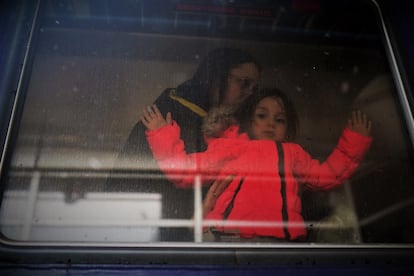How Kyiv’s train station has become a place where families are being torn apart
With roads unstable and gasoline in short supply, rail has become one of the few options for those escaping the conflict in Ukraine. Women and children are fleeing, while men must stay and defend their country

With tears in their eyes and exhaustion on their faces, some of the women don’t want to take the last step. They end up doing so with a push from their husbands, lifting them up onto the train carriage steps. They know that they are going to be separated for an unknown period of time. Pain dominates the final goodbye, which is accompanied by hugs, caresses and glazed looks. Some of the men raise their fists in the air to the cry of: “Glory to Ukraine!” or “We will be victorious!” While others cling onto their children, who are eventually handed over to their mothers on the train.
The station in Kyiv is a seething mass of people, from its entrance to its platforms. The green lights on the information board show that most routes are still running. This infrastructure hub is an umbilical cord that joins a warzone in the center of the country with the less-affected area in the west. Most of the people traveling are women and children, while those saying goodbye are Ukrainian men – obliged by martial law to stay and fight for their country.
Natalia, 38, and wearing a ski suit, explains from the chaotic scene that no one is having to pay for a ticket. She is joined by her friend Oxsana, also 38, and her daughter. They have just escaped from Irpin, one of the areas on the outskirts of the capital that is suffering the most from the Russian attacks. “This week we didn’t leave the shelter, because a lot of bombs were falling,” she explains. With them is Serguei, her husband, who will be returning to Kyiv once in Lviv.
More than a million people have already escaped from the war in Ukraine, which began on February 24 when Russian President Vladimir Putin ordered the attack and invasion of the neighboring country. With gas stations out of supplies and the situation unstable on some of the highways due to fighting and troop movements, the Kyiv train station has become the main escape route from the conflict. There is barely time between one train and the next. The trash cans are overflowing and there are objects that have been abandoned – things like a baby carriage or a pet’s cage.

Ten-hour journey
The tension rises every time that the empty trains arrive, and hundreds of people crowd around their doors. There are no fights or arguments, but no one wants to be left without a seat and there is jostling to find a space. When there is no more room – and that means the corridors and spaces between the trains are also packed – people stop boarding. Assuming there are no delays, an eight- to 10-hour journey awaits.
The atmosphere of paranoia that has enveloped the city is palpable here too. The Kyiv authorities are seeing saboteurs and enemy collaborators everywhere. Half-a-dozen police officers intercept three youngsters. They make them stand with their legs spread and their palms on one of the carriages. They point their weapons at them while they check their identity, question them briefly and look at their luggage. A few minutes later, they let them continue their journey to Lviv, as if nothing had happened.
Tu suscripción se está usando en otro dispositivo
¿Quieres añadir otro usuario a tu suscripción?
Si continúas leyendo en este dispositivo, no se podrá leer en el otro.
FlechaTu suscripción se está usando en otro dispositivo y solo puedes acceder a EL PAÍS desde un dispositivo a la vez.
Si quieres compartir tu cuenta, cambia tu suscripción a la modalidad Premium, así podrás añadir otro usuario. Cada uno accederá con su propia cuenta de email, lo que os permitirá personalizar vuestra experiencia en EL PAÍS.
¿Tienes una suscripción de empresa? Accede aquí para contratar más cuentas.
En el caso de no saber quién está usando tu cuenta, te recomendamos cambiar tu contraseña aquí.
Si decides continuar compartiendo tu cuenta, este mensaje se mostrará en tu dispositivo y en el de la otra persona que está usando tu cuenta de forma indefinida, afectando a tu experiencia de lectura. Puedes consultar aquí los términos y condiciones de la suscripción digital.
More information
Últimas noticias
Most viewed
- Reinhard Genzel, Nobel laureate in physics: ‘One-minute videos will never give you the truth’
- Oona Chaplin: ‘I told James Cameron that I was living in a treehouse and starting a permaculture project with a friend’
- Pablo Escobar’s hippos: A serious environmental problem, 40 years on
- Why we lost the habit of sleeping in two segments and how that changed our sense of time
- Chevy Chase, the beloved comedian who was a monster off camera: ‘Not everyone hated him, just the people who’ve worked with him’











































